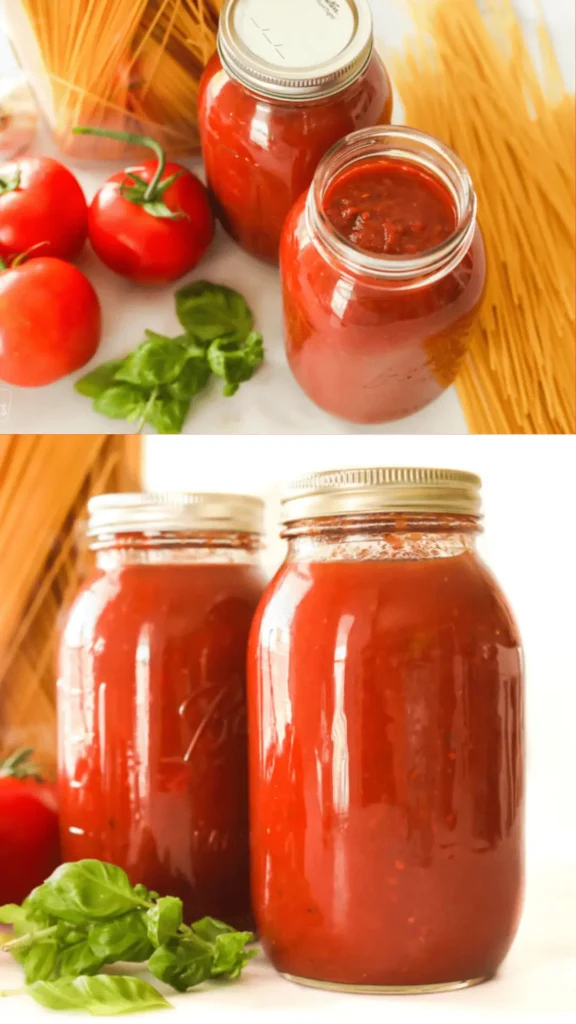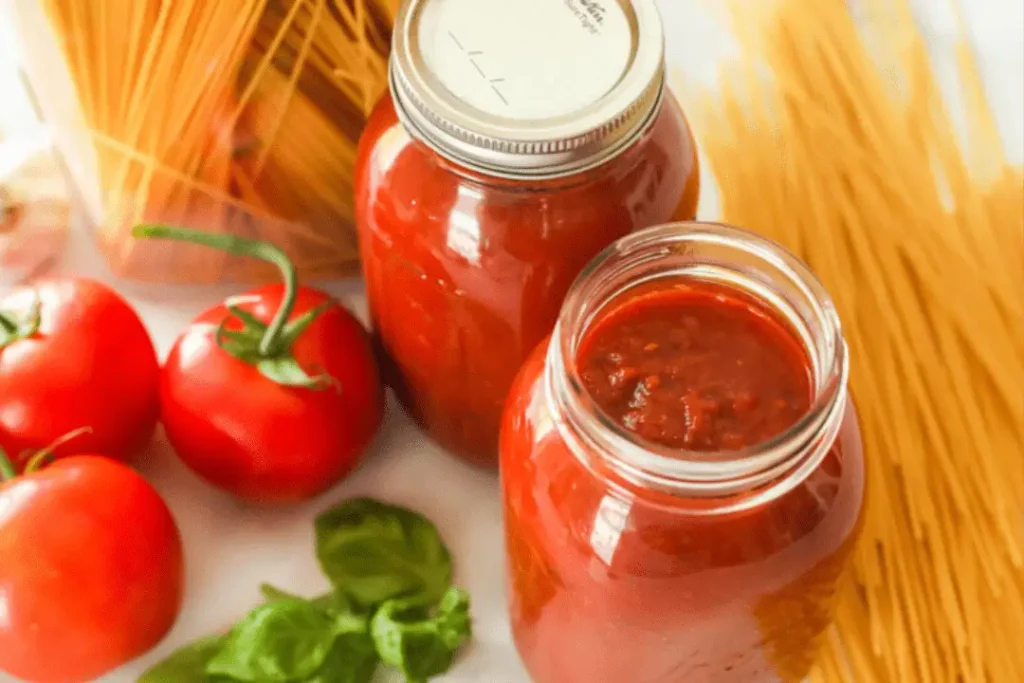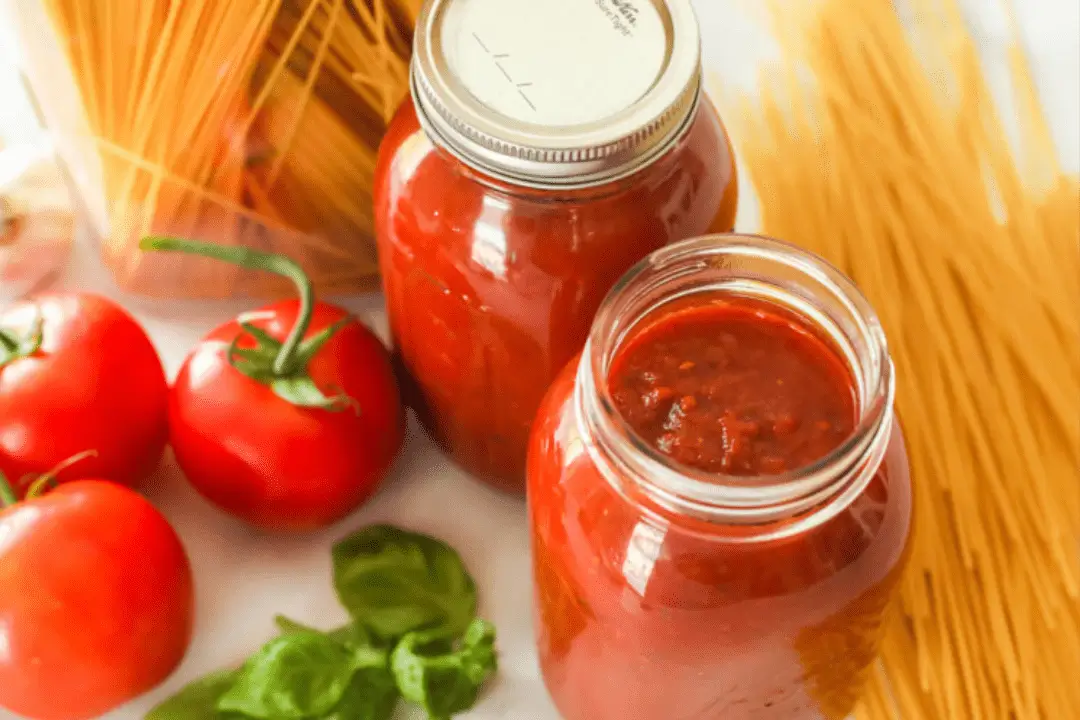If you love making food at home, canned spaghetti sauce is a great choice. It captures the taste of fresh tomatoes and herbs. Plus, it’s easy to have a tasty sauce ready when you need it. I’ve perfected this recipe over years and can’t wait to share it with you.

Ingredients
Here’s what you’ll need for this delicious sauce:
- Tomatoes – 10 pounds, peeled and chopped
- Onions – 2 large, finely chopped
- Garlic – 6 cloves, minced
- Olive Oil – 1/4 cup
- Salt – 2 tablespoons
- Sugar – 1 tablespoon (optional, to taste)
- Basil – 1/4 cup, fresh chopped (or 2 tablespoons dried)
- Oregano – 2 tablespoons, dried
- Black Pepper – 1 teaspoon, ground
- Red Pepper Flakes – 1/2 teaspoon (optional, for heat)
- Lemon Juice – 1/2 cup (for acidity adjustment)
Timing
- Preparation Time: 30 minutes
- Cooking Time: 2 hours
- Total Time: 2 hours 30 minutes
Step-by-Step Process for Preparing Canned Spaghetti Sauce
-
Prepare Your Ingredients: Peel and chop the tomatoes. To peel them easily, blanch them in boiling water for a minute, then put them in an ice bath. The skins will come off. Chop the onions and garlic finely.
-
Cook the Vegetables: Heat olive oil in a large pot over medium heat. Add the onions and garlic, sautéing until they’re soft and translucent.
-
Add Tomatoes and Seasonings: Add the chopped tomatoes, along with salt, sugar, basil, oregano, black pepper, and red pepper flakes. Stir well to combine.
-
Simmer the Sauce: Bring the mixture to a simmer, then reduce the heat to low. Let it cook uncovered for about 2 hours, stirring occasionally, until the sauce thickens to your liking.
-
Adjust Acidity: Add lemon juice to the sauce. This balances the flavors and ensures a safe acidity level for canning.
-
Blend (Optional): For a smoother sauce, blend it using an immersion blender or in batches in a regular blender. Be careful with the hot liquid!
-
Can the Sauce: Ladle the hot sauce into sterilized jars, leaving about 1/2 inch of headspace. Wipe the rims, apply the lids, and screw on the bands until fingertip-tight.

How to Choose the Best Tomatoes for Your Sauce
Choosing the right tomatoes is key for a rich sauce. Go for Roma or San Marzano tomatoes for their meaty texture and low moisture. These varieties make a thicker sauce with a strong tomato flavor. At farmers’ markets, look for vine-ripened tomatoes that are bright red and without blemishes.
The Importance of Sanitizing Jars for Canning Spaghetti Sauce
Sanitizing jars is crucial for canning to avoid spoilage and ensure safety. Wash the jars, lids, and bands in hot, soapy water, then sterilize them in boiling water for at least 10 minutes. Keep the jars hot until you’re ready to fill them to prevent cracking.
Seasoning Your Canned Spaghetti Sauce: Tips and Tricks
It’s important to adjust the seasoning to match your taste. Taste the sauce while it simmers and adjust the salt, sugar, and herbs as needed. Add fresh herbs near the end for a fresh flavor. Use dried herbs earlier to get the best aroma.
How Long Does Homemade Canned Spaghetti Sauce Last?
Homemade spaghetti sauce can last up to a year if stored in a cool, dark place. Once opened, keep it in the fridge and use it within a week. Always check the seal before using; if it’s loose or bulging, throw it away.
Water Bath Canning Method for Spaghetti Sauce
For tomato-based sauces, use the water bath canning method. Put the jars in boiling water, making sure they’re covered by at least an inch of water. Process for 35 minutes, adjusting for altitude as needed. Let the jars cool on a towel for 12-24 hours after processing.
Pressure Canning Versus Water Bath for Spaghetti Sauce
Water bath canning works for high-acid sauces, but pressure canning is needed for low-acid foods. If you add meat or low-acid veggies, use a pressure canner. It uses high temperatures to kill harmful bacteria and spores.
Common Mistakes to Avoid When Making Canned Spaghetti Sauce
- Skipping the Acid: Always add lemon juice or vinegar to keep the acidity right.
- Overfilling Jars: Leave enough space in the jars for expansion during processing.
- Not Removing Air Bubbles: Use a non-metallic tool to get rid of air bubbles before sealing.
Adding Meat to Your Canned Spaghetti Sauce: Do’s and Don’ts
Adding meat can make your sauce taste better, but be careful. Cook the meat well before adding it to the sauce. Use a pressure canner for safety, as meat needs high temperatures to be preserved.
Vegan and Gluten-Free Canned Spaghetti Sauce Variations
For a vegan version, skip the meat and use vegetable stock instead of water. Make it gluten-free by choosing gluten-free herbs and spices. You can also add veggies like bell peppers or mushrooms for extra flavor.
Testing and Adjusting the Acidity in Your Spaghetti Sauce
Acidity is key for safe canning. Test the sauce with a pH meter or pH strips; it should be 4.6 or lower. Add more lemon juice or citric acid if needed, but test the pH again after adding acid.
Creative Ways to Use Your Canned Spaghetti Sauce
Your canned spaghetti sauce is great for many dishes. Use it for pasta, lasagna, or pizza. It’s also good in soups, stews, and casseroles. Try it in your favorite recipes!
Conclusion
Canning your spaghetti sauce is rewarding and keeps summer flavors in your kitchen all year. With the right ingredients and techniques, you can make a delicious and safe sauce. This guide is perfect for both beginners and experienced canners.
FAQs
-
Can I use canned tomatoes instead of fresh?
Yes, but the flavor and texture may differ. If using canned, opt for high-quality whole tomatoes. -
Is it necessary to add sugar?
Sugar balances the acidity and enhances the flavor, but it’s optional based on your taste preference. -
Can I use a food processor to chop the tomatoes?
Absolutely! It can save time and achieve a consistent texture. -
How do I know if my jars are sealed properly?
Once cooled, the lids should not flex up and down when pressed. If a lid pops, the jar is not sealed. -
Can I freeze the sauce instead of canning it?
Yes, you can freeze the sauce in airtight containers for up to 6 months. Thaw in the refrigerator before use.
